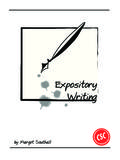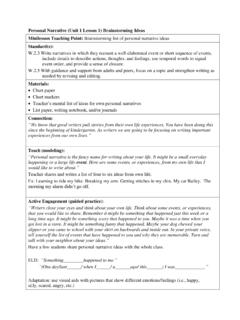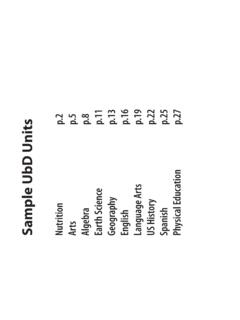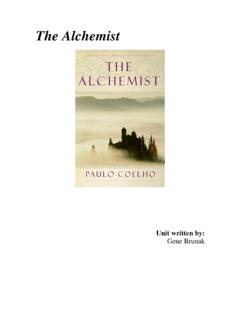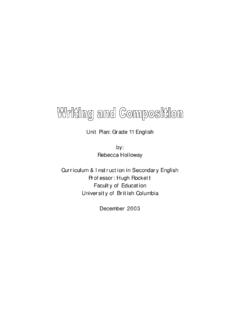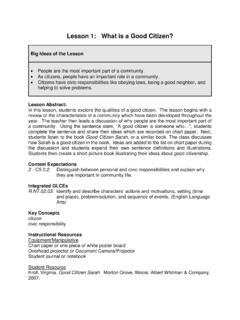Transcription of Narrative Writing Skills Final
1 2001 Margot Southall 1 narrative Writing Contents unit 1: Writing Effective Story Beginnings lesson 1: Identifying Four Techniques lesson 2: Revising an Ineffective Story Beginning lesson 3: Establishing Setting and Plot lesson 4: Revising a Beginning Using an Alternative Technique lesson 5: Writers Workshop Revising a Writing Sample unit 2: Writing Effective Story Endings lesson 1: Identifying Four Techniques lesson 2: Revising an Ineffective Story Ending lesson 3: Revising an Ending Using an Alternative Technique lesson 4: Writers Workshop The Before and After Format unit 3: Writing Detail and Description lesson 1: Identifying the Components of Effective Descriptive Writing lesson 2: Detail Generating Questions lesson 3: Describing a Character s Emotions, Thoughts, and Feelings lesson 4: Revising a Brief, General Description with Specific Detail lesson 5: Writers Workshop Revising a Writing Sample unit 4: Writing a Main Event lesson 1: Identifying the Components of a Fully Expanded Main Event lesson 2: Expanding a Story Summary lesson 3: Composing A Fully Expanded Main Event lesson 4: Writers Workshop Revising a Writing Sample unit 5: Writing to a Prompt Writers Workshop Completing a Story Within a Timed Format unit 6.
2 Short-Term Writing Projects Completing a Story Using a Writing Process Approach Acknowledgement The Curriculum Services Canada Foundation provided financial support to the writer of this resource through its Grants and Awards Program for Teachers. 2001 Margot Southall2 Introduction The purpose of the Narrative Writing program is for students to increase their effectiveness as writers. This goal is achieved by applying specific Skills or techniques in each of the following four components of a Narrative story: An Effective Story Beginning A Satisfying Story Ending Detail and Description An Expanded Main Event Process Writing can often be frustrating for many students. This program provides instruction in specific techniques so that revisions are reduced and the clarity of students Writing increases.
3 The techniques are based on those used by adult authors of Narrative text, presented in a step-by-step format to meet the needs of elementary students. Units 1 4 The units are sequenced in order of difficulty. The beginning and ending of a story are the easiest to write and revise. These units are followed by exercises that focus on generating description and detail. This step is necessary before students can write a fully expanded main event that includes action, dialogue, and description. Lessons in each of these four units progress from identifying the techniques authors use, then revising a given prompt, and finally applying the practised techniques to a piece of the student s own Writing . Students compare the original and revised pieces of Writing in a Before and After format to demonstrate the power of revision.
4 Units 5 6 unit 5 requires the students to apply the Skills from each of the preceding four units to complete a Narrative piece in response to a provided prompt. This task provides explicit practice in Writing to a prompt within a set timeframe. A planning form and timeline is provided to assist students in completing each component of the story within 45 minutes. By having the whole class write to a common prompt, the teacher is able to assess student progress in each of the Skills . unit 6 provides a framework and timetable that requires students to complete a Narrative story over 6 7 days. Each step in the Writing process is outlined as a guideline for student Writing . Narrative Structure When we examine the underlying pattern of Narrative stories we find two common types: 1.
5 Character-Problem-Solution Narrative : In this type of Narrative the emphasis is on a main character who undergoes a problem or struggle brings about a solution grows and changes as a result of the struggle and solution 2. Personal Experience Narrative : These narratives are told in the first person and emphasize 2001 Margot Southall3 an interesting experience rather than a character description and detail As you complete each unit , provide examples for each of these two types of narratives and have students apply the practised Skills to Writing and revising each one. Literature Models and Curriculum Connections Excerpts from specific novels are cited as examples in each unit . The teacher may choose to use these examples or select excerpts from novels that they have studied with the class.
6 Many exercises suggest that teachers have students apply the new skill to revise a prompt reflecting a current Social Studies or Science topic. To do this, the teacher may adapt the Blackline Masters so that they refer to a Narrative that takes place in contexts such as medieval times, an ancient civilization, or during the early settlement of Canada. Individualizing the Program: Accommodations and Modifications Each component of the Writing Skills program presents specific techniques in a scaffolded format, with the teacher first modelling the skill, then guiding the students in practising the skill, and finally providing opportunity for independent application. The following teaching strategies have been incorporated throughout the program to address the needs of the range of developmental levels in any one classroom and to provide support for students experiencing difficulty with the reading and Writing process.
7 Read-Aloud: The teacher reads the literature selection to the students to model the required technique. Pre- Writing Activities: Each lesson addresses background knowledge and understanding of the specific Writing skill during the Introducing the Skill and Modelling the Skill sections. Shared and Modelled Writing : The teacher records student input in a shared- Writing format and models the composition process, verbalizing each step in a Think-Aloud approach. Co-operative Learning: This format, which provides access to peer support in a small group, may be used for the completion of each written response. Graphic Organizers: Organizers assist development of a main idea and provide an organizational structure for planning a complete piece of Writing .
8 Focus on Process a Series of Small Successes: A step-by-step approach provides a series of small successes to encourage the growth of confidence and Skills . Risk-Taking Is Encouraged: Most of the practice activities focus on revising a prompt rather than individual student work, which removes the fear of risk-taking associated with having your own work evaluated. Only when the skill has been thoroughly practised in this manner are students expected to apply one skill at a time to revise their own Writing . References Gardner, John. The Art of Fiction: Notes on Craft for Young Writers. Vintage Books, 1991. Hood, Ann. Creating Character Emotions. Writers Digest Books, 1998. Kress, Nancy. Beginnings, Middles & Ends. Writers Digest Books, 1999. 2001 Margot Southall4.
9 Description. Writers Digest Books, 1999.. Dynamic Characters: How to Create Personalities That Keep Readers Captivated. Writers Digest Books, 1998. Mariconda, Barbara. The Most Wonderful Writing Lessons Ever. New York: Scholastic, 1999. McClanahan, Rebecca. Word Painting: A Guide to Writing More Descriptively. Writers Digest Books, 2000. Rubie, Peter. The Elements of Storytelling: How to Write Compelling Fiction. John Wiley & Sons, 1995. 2001 Margot Southall5 unit 1: Writing Effective Story Beginnings lesson 1 Purpose Analyse story beginnings from literature as models for student Writing . Identify four techniques for a compelling beginning: action, dialogue and/or exclamation, thought or question, and sound effect. Materials Key novel: The BFG by Roald Dahl.
10 Other examples include Hatchet by Gary Paulsen, Lost in the Barrens by Farley Mowat, Amish Adventure by Barbara Smucker, Bridge to Terabithia by Katherine Paterson, Blue Heron by Avi, Poppy by Avi, Cricket in Times Square by George Selden, and Charlotte s Web by White. Chart paper and markers Blackline Masters 1 8 Teacher Preparation Review the chapter beginnings in the novels (listed under Modelling the Skill ) and the technique that these passages represent. Prepare a chart of the four techniques entitled Effective Story Beginnings. Introducing the Skill Building Background Knowledge and Experience Discuss the importance of making a good impression when you first meet someone. Brainstorm and list the types of behaviour that leave an unfavourable impression, such as avoidance of eye contact, talking only about yourself ( , ), boring small talk that never seems to get to the point, and overly factual conversations.
